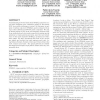Free Online Productivity Tools
i2Speak
i2Symbol
i2OCR
iTex2Img
iWeb2Print
iWeb2Shot
i2Type
iPdf2Split
iPdf2Merge
i2Bopomofo
i2Arabic
i2Style
i2Image
i2PDF
iLatex2Rtf
Sci2ools
CORR
2011
Springer
2011
Springer
An Empirical Study of Real-World SPARQL Queries
Understanding how users tailor their SPARQL queries is crucial when designing query evaluation engines or fine-tuning RDF stores with performance in mind. In this paper we analyze 3 million real-world SPARQL queries extracted from logs of the DBPedia and SWDF public endpoints. We aim at finding which are the most used language elements both from syntactical and structural perspectives, paying special attention to triple patterns and joins, since they are indeed some of the most expensive SPARQL operations at evaluation phase. We have determined that most of the queries are simple and include few triple patterns and joins, being Subject-Subject, Subject-Object and Object-Object the most common join types. The graph patterns are usually star-shaped and despite triple pattern chains exist, they are generally short. Categories and Subject Descriptors H.2.3 [Database Management]: Languages—Query languages General Terms Languages, Measurement Keywords SPARQL, usage analysis, RDF store, ...
| Added | 13 May 2011 |
| Updated | 13 May 2011 |
| Type | Journal |
| Year | 2011 |
| Where | CORR |
| Authors | Mario Arias, Javier D. Fernández, Miguel A. Martínez-Prieto, Pablo de la Fuente |
Comments (0)

